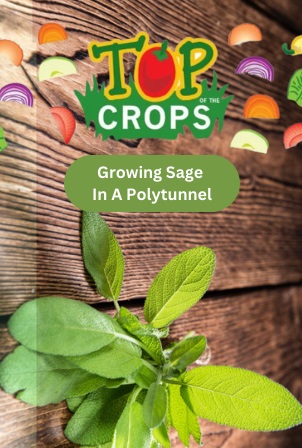Sage, Salvia officinalis, is a popular cottage garden herb and one with a long culinary and herbal healing history in the UK. It can be a good choice for a polytunnel garden, whether you grow it in a dedicated herb garden, or as a companion plant in other food-producing schemes.
Sage is a member of the Salvia genus that also gives us a number of other herbs and ornamental plants for our gardens. Common sage is generally considered to be one of the most useful for culinary use, and while it has a range of uses, it is most famously paired with onions in stuffings and other recipes.
Common sage serves as the quintessential culinary sage. It forms a compact mound of aromatic, velvety, olive-green leaves and boasts attractive mauve flowers in the early to mid-summer period. Being hardy and evergreen, it retains its foliage throughout the year, reaching heights and widths of up to 1m (3ft). Its flowers not only add ornamental value but also attract pollinating insects by providing nectar.
| Jan | Feb | Mar | Apr | May | Jun | Jul | Aug | Sep | Oct | Nov | Dec | |
| Sow |  |
 |
 |
|||||||||
| Plant |  |
 |
 |
|||||||||
| Harvest |  |
 |
 |
 |
 |
 |
 |
Sage loves a warm, sunny and sheltered spot so a polytunnel should be ideal, though you might also grow this herb outdoors in a suitably sheltered and sunny position. Full sun positioning will bring out the best flavour in the leaves and ensure optimal essential oil production.
In order to provide the best possible growing conditions, it is best to add plenty of compost or well-rotted manure to the tops of your polytunnel beds. (In a 'no dig' system, this should be left on top rather than dug in, so as to preserve and protect the soil ecosystem.)
Sage is relatively easy to grow. You can either grow it from seed or purchase plants to position where you wish to do so in your garden.
Sow sage between March and May, indoors earlier in this time period of outside once risk of frost has passed.
Sow the sage seeds you have selected into seed trays or small pots, covering them lightly. Place them into a propagator or cover with glass or plastic, and place them in a bright, sunny spot inside your home. Seeds should germinate within around 3 weeks.
Once the seedlings emerge, remove the cover or remove them from the propagator and prick them out and pot them on once they are large enough to handle. Plant them out once they are around 10cm tall, and once all risk of frost has passed, after hardening them off.
Select a sage plant from a nursery or propagate your own from seeds or cuttings.
Prepare the container or designated area for growing sage by incorporating a top layer of homemade compost or other organic material.
Dig a hole large enough to accommodate the plant's roots, or add a layer of peat-free soil-based compost to the bottom of your container.
Carefully remove the plant from its original pot and position it in the hole or new container.
Fill the surrounding soil or growing medium around the plant, gently patting it down.
Thoroughly water the sage, ensuring proper drainage to prevent waterlogging.
Following this straightforward process should yield sage ready for harvest during the summer of the same year.
Sage thrives in various environments, requiring full sun exposure (or a well-lit indoor area) and preferring moderately moist, fertile, and well-draining conditions. Here are several options for cultivating sage:
Indoors, year-round, in containers.
Outdoors, in containers within your garden.
In a designated herb garden plot.
Integrated into a mixed bed or border alongside other perennial herbs and ornamental flowers.
Utilized as a companion plant within your vegetable garden.
When planting sage in containers, opt for a peat-free soil-based potting mix. For sage grown in raised beds or directly in the ground, select a sheltered location with ample sunlight and protection from strong winds. In colder regions, it's advisable to provide some winter protection to maintain the leaves' condition. Keep this in mind when choosing a growing location.
Sage plants are not difficult to care for as long as you keep the basic needs of the plants in mind. These are fairly resilient and low-maintenance herbs to grow in your garden.
Water your sage plants regularly, especially during dry spells. Avoid overwatering however, as sage cannot tolerate having wet or waterlogged roots. In the winter, raise container grown sage up off the ground to allow for good drainage if growing outdoors, and be careful not to overwater during colder weather.
Sage needs a growing position in full sun, where they are also sheltered from strong winds.
The soil should be moist yet free-draining, with plenty of organic matter. If you have heavy clay soil you may be better growing this herb in a raised bed or container for best results since these are not plants that can tolerate waterlogging.
Sage will perform best at temperatures between 15 and 21 degrees C. and they prefer a location with moderate humidity. A polytunnel can help you to provide the ideal conditions for growing sage, especially where conditions elsewhere in a garden are not ideal where you live.
To make sure that the leaves remain in good condition over the winter months, you may wish to give the tops a little more protection with a layer of horticultural fleece, though this extra protection may not be required in a polytunnel in more southerly portions of the UK.
Overfeeding sage can actually be counterproductive and it is important not to overfeed – especially with high-nitrogen fertilizers.
Instead, to maintain soil fertility, protect the soil, conserve soil moisture etc., add an organic mulch around the sage each spring. A good quality compost is ideal for this purpose. If growing sage in a container, make sure that you repot every 2-3 years with new growing medium.
Pruning your sage plants, cutting them back hard after they flower as well as just deadheading, will help to maintain an attractive shape for your sage plant and will encourage lots of new foliage growth.
Sage can be propagated by means of softwood cuttings, which are taken in the early summer. You can also try layering sage – rooting side branches into the ground near the parent plant to obtain new plants. Of course, you might also propagate sage from seed, though seeds from varietals will not always produce offspring with the same foliage hues.
Sage is an evergreen and so its leaves can be picked at any time for use in the kitchen. Harvest aromatic herbs in the morning where possible, in sunny conditions.
Sage boasts a hearty, peppery flavour that extends beyond its traditional use in sage and onion stuffing. Its versatility shines as chopped sage leaves enhance a multitude of dishes, from soups and pasta sauces to sausages and marinades.
Beyond its culinary prowess, sage is reputed to offer numerous health benefits, reflected in its botanical name Salvia, derived from the Latin "salvare," meaning to heal.
Sage can be used fresh or it can be dried or frozen for later use. Sage takes a while to dry but when it is dry it can keep for a year or so in an air-tight container.
Sage seeds become ripe for saving when the blooms transition to a brown, dry state. Once fully dried, delicately crush the seed heads between your hands and then proceed to carefully separate the seeds from the chaff through winnowing. You can save the seeds to sow next year.
Sage, as an aromatic herb, is said to be a good companion plant for a wide range of crops, including brassicas (as a trap crop that attracts cabbage butterflies), beans, carrots, strawberries and tomatoes.
In general, sage can benefit all crops that require pollinators by attracting honey bees and other beneficial insects to your polytunnel.
However, it is important to note that growing sage near cucumbers is not advisable, as sage and some other aromatic herbs can hinder their growth. Similarly, it's best to keep rue and fennel away from sage, as they may also impede its growth.
In addition to the standard variety, there exists a plethora of cultivated varieties of S. officinalis. Among these, the widely favoured purple sage (S. officinalis ‘Purpurascens’) stands out with its captivating, dusky purple foliage that persists year-round.
Various cultivars offer diverse aromas, along with an array of flower and foliage colours, another of which is 'Icterina' with yellow leaves, and tricolour sage, which has cream and green leaves, tinged with pink.
Sage typically exhibits robustness, hardiness, and longevity, often persisting for many years. To ensure its optimal growth, it's essential to provide a warm, sunny location with soil or potting mix that allows for effective drainage.
When it comes to compost, there are two primary options: homemade garden compost and commercially available seed or potting compost. Garden compost, derived from decomposed plant waste, serves as a natural soil enhancer, improving fertility, structure, and water retention.
On the other hand, seed or potting composts are specifically formulated for growing seedlings or plants in containers. A variety of peat-free composts are readily available, comprising a blend of ingredients like loam, composted bark, coir, and sand. Alternatively, you can customize your mix according to preference.
It's crucial to avoid waterlogged compost, as this can lead to detrimental effects on sage growth.
While sage may occasionally encounter pests such as rosemary beetles, sage leafhopper, and capsid bugs, these typically do not pose severe threats. Control measures are often unnecessary, but you can manually remove any affected leaves if desired.
Sage benefits from cultivation in a polytunnel where you should find it relatively easy to maintain the warm, sheltered and sunny conditions this herb prefers. Remember, too, that many other plants in your polytunnel will benefit from having sage growing close by as a companion plant.
BBC Good Foods. (2022) Sage Recipes. [online] Available at: https://www.bbcgoodfood.com/recipes/collection/sage-recipes [accessed 21/03/24]
